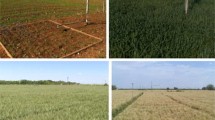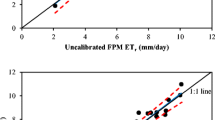Abstract
The use of crop models in sloping areas is questionable when relief is not taken into account, as relief affects infiltration, radiation, and aerodynamic processes. The objective of this work is to evaluate the performance of FAO-AquaCrop model in simulating crop evapotranspiration, water balance, and biomass production in hilly areas using in situ measurements. The experiment was conducted in the Cap-Bon region, north-eastern Tunisia, on two wheat fields located on opposite sloping rims (A and B) and one control field (C) on a flat terrain: field A is SE-oriented with 5% slope and B is NW-oriented with 6% slope. Three flux stations were used to monitor automatically actual evapotranspiration (ET) and climatic factors whereas soil moisture and biomass production were measured manually. Model’s outputs were compared to actual measurements using statistical indicators: slope of the regression line, root mean squared error (RMSE), and the coefficient of determination (R2). Actual ET varied between 1 and 2 mm during crop initial stage and 3–4 mm during mid-season stage. The ET/ETo ratio during mid-season was 0.81, 0.74, and 1.03, respectively for fields A, B, and C, well below the commonly used value of 1.15. Comparison between measured and simulated ET shows a substantial overestimation of the model in sloping fields with 6–20% higher averages and a RMSE of 0.47–0.77 mm/day. AquaCrop seems to simulate reasonably well water balance, particularly in flat conditions. RMSE of water content in the top 100 cm soil-layer was in the range 41–67 mm/m, representing a relative error of 11–21%. Simulated and measured biomass values presented similar trends (R2 = 0.86–0.94) with a systematic difference, indicating that AquaCrop outputs could be improved by a correction factor.






Similar content being viewed by others
References
Aguilar C, Herrero J, Polo MJ (2010) Topographic effects on solar radiation distribution in mountainous watersheds and their influence on reference evapotranspiration estimates at watershed scale. Hydrol Earth Syst Sci 14:2479–2494
Allen RG, Pereira LS, Raes D, Smith M (1998) Crop evapotranspiration–guidelines for computing crop water requirements–FAO irrigation and drainage paper 56. FAO, Rome
Araya A, Habtu S, Hadgu KM, Kebede A, Dejene T (2010) Test of AquaCrop model in simulating biomass and yield of water deficient and irrigated barley (Hordeumvulgare). Agric Water Manag 97:1838–1846
Ben Mechlia N, Mekki I, Zante P.(1998) Spatialisation de l'activité agricole et de l'occupation du sol dans une région au relief accidenté. in proc. of the int. symposium Satellite-based observation : a tool for the study of the Mediterranean basin. Tunis, 23-27 november 1998, CNES, France.
Ben-Mechlia N, Oweis T, Masmoudi MM, Mekki I, Ouessar M, Zante P, Zekri S (2008) Conjunctive use of rain and irrigation water from hill reservoirs for agriculture in Tunisia. ICARDA, Aleppo
Bois B, Pieri P, Leeuwen CV, Wald L, Huard F, Gaudillere JP, Saur E (2008) Using remotely sensed solar radiation data for reference evapotranspiration estimation at a daily time step. Agric Forest Meteorol 148:619–630
Boudhina N, Masmoudi M M, Ben Mechlia N, Zitouna R, Mekki I, Prévot L, Jacob F (2017), Evapotranspiration of wheat in hilly topography : Results form measurement using a set of Eddy covariance stations. in M. Ouessar et al. (eds.) Water and Land Security in Drylands, pp. 67-76, Springer int. publ. AG 2017, https://doi.org/10.1007/978-3-319-54021-4_7
Boudhina N, Masmoudi M M, Jacob F, Prévot L, Zitouna-chebbi R, Mekki I, Ben Mechlia N (2018). Measuring crop evapotranspiration over hilly area. in A. Kallel et al. (eds.), Recent Advances in Environmental Science from the Euro-Mediterranean and Surrounding Regions, Advances in Science, Technology & Innovation, pp. 909-911, Springer int. Publ. AG 2018, https://doi.org/10.1007/978-3-319-70548-4_266
Brisson N, Gary C, Justes E, Roche R, Mary B, Ripoche D, Zimmer D, Sierra J, Bertuzzui P, Burger P, Bussiere F, Cabidoche YM, Cellier P, Debaeke P, Gaudillere JP, Maraux F, Seguin B, Sinoquet H (2003) An overview of the crop model STICS. Eur J Agron 18:309–332
Duchemin B, Maisongrande P, Boulet G, Benhadj I (2008) A simple algorithm for yield estimates: evaluation for semi-arid irrigated winter wheat monitored with green leaf area index. Environ Modell Softw 23:876–892
Evett SR, Howell TA, Baumhardt RL, Copeland KS (2012a) a. Can weighing lysimeter ET represent surrounding field ET well enough to test flux station measurements of daily and sub-daily ET? Adv. Water Res 50:79–90
Evett SR, Kustas WP, Gowda PH, Anderson MC, Prueger JH, Howell TA (2012b) b. Overview of the Bushland evapotranspiration and agricultural remote sensing experiment 2008 (BEAREX08): a field experiment evaluating methods for quantifying ET at multiple scales. Adv. Water Res 50:4–19
Foster T, Brozović N, Butler AP, Neale CMU, Raes D, Steduto P, Fereres E, Hsiao TC (2017) AquaCrop-OS: An open source version of FAO's crop water productivity model. Agric Water Manag 181:18–22
Garcia-Vila M, Fereres E, Mateos L, Orgaz F, Steduto P (2009) Deficit irrigation optimization of cotton with AquaCrop. Agron J 101:477–487
Jones JW, Hoogenboom G, Porter CH, Boote KJ, Batchelor WD, Hunt LA, Wilkens PW, Singh U, Gijsman AJ, Ritchie JT (2003) DSSAT cropping system model. Europ J Agron 18:235–265
Liu J, Wiberg D, Zehnder A, Yang H (2007) Modeling the role of irrigation in winter wheat yield, crop water productivity, and production in China. Irrigation Sci 26:21–33
Liu M, Bárdossy A, Li J, Jiang Y (2012) Physically-based modeling of topographic effects on spatial evapotranspiration and soil moisture patterns through radiation and wind. Hydrol Earth Syst Sci 16:357–373
Mekki I, Albergel J, Ben Mechlia N, Voltz M (2006) Assessment of overland flow variation and blue water production in a farmed semi-arid water harvesting catchment. Phys Chem Earth 31:1048–1061
Raes D, Steduto P, Hsiao TC, Fereres E (2009) Aquacrop the FAO-crop model to simulate yield response to water: I. Main algorithms and software description. Agron J 101:438–447
Raes D, Steduto P, Hsiao TC, Fereres E (2012) Calculation procedures. AquaCrop version 4.0. FAO land and water development division, Rome
Rana G, Ferrara RM, Martinelli N, Personnic P, Cellier P (2007) Estimating energy fluxes from sloping crops using standard agrometeorological measurements and topography. Agric For Meteorol 146:116–133
Roupsard O, Bonnefond JM, Irvine M, Berbigier P, Nouvellon Y, Dauzat J, Taga S, Hamel O, Jourdan C, Saint-André L, Mialet-Serra I, Labouisse JP, Epron D, Joffre R, Braconnier S, Rouzière A, Navarro M, Bouillet JP (2006) Partitioning energy and evapo-transpiration above and below a tropical palm canopy. Agric For Meteorol 139:252–268
Salemi HMA, Lee TS, Mousavi SF, Ganji A, Yusoff MK (2011) Application of AquaCrop model in deficit irrigation management of Winter wheat in arid region. Af J Agric Res 610:2204–2215
Saxton KE, Rawls WJ (2006) Soil water characteristic estimates by texture and organic matter for hydrologic solutions. Soil Sci Soc Am J 70:1569–1578
Sghaier N, Masmoudi MM, Ben Mechlia N (2014) Paramétrage du modèle AquaCrop pour la simulation de la culture du blé dur. Revue des Régions Arides 35:1351–1360
Steduto P, Hsiao CT, Fereres E (2007) On the conservative behaviour of biomass water productivity. Irrigation Sci 25:189–207
Steduto P, Hsiao TC, Raes D, Fereres E (2009) Aqua-Crop the FAO crop model to simulate yield response to water: I. Concepts and underlying principles. Agron J 101:426–437
Steduto P, Hsiao TC, Fereres E, Raes D (2012) Crop yield response to water. FAO Irrigation and Drainage Paper, vol 66. FAO, Rome
Twine TE, Kustas WP, Norman JM, Cook DR, Houser PR, Meyers TP, Prueger JH, Starks PJ, Wesely ML (2000) Correcting eddy-covariance flux underestimates over a grassland. Agric For Meteorol 103:279–300
Zhao X, Liu Y (2014) Relative contribution of the topographic influence on the triangle approach for evapotranspiration estimation over mountainous areas. Adv. Meteorol:1–16
Zitouna-Chebbi R, Prévot L, Jacob F, Mougou R, Voltz M (2012) Assessing the consistency of eddy covariance measurements under conditions of sloping topography within a hilly agricultural catchment. Agric For Meteorol 164:123–135
Funding
This study was financially supported by the French Institute of Research for Development (IRD), the National Institute of Agronomy of Tunisia (INAT) and the ANR-ALMIRA project.
Author information
Authors and Affiliations
Corresponding author
Additional information
This article is part of the Topical Collection on Geo-environmental integration for sustainable development of water, energy, environment, and society
Rights and permissions
About this article
Cite this article
Boudhina, N., Masmoudi, M.M., Alaya, I. et al. Use of AquaCrop model for estimating crop evapotranspiration and biomass production in hilly topography. Arab J Geosci 12, 259 (2019). https://doi.org/10.1007/s12517-019-4434-9
Received:
Accepted:
Published:
DOI: https://doi.org/10.1007/s12517-019-4434-9




